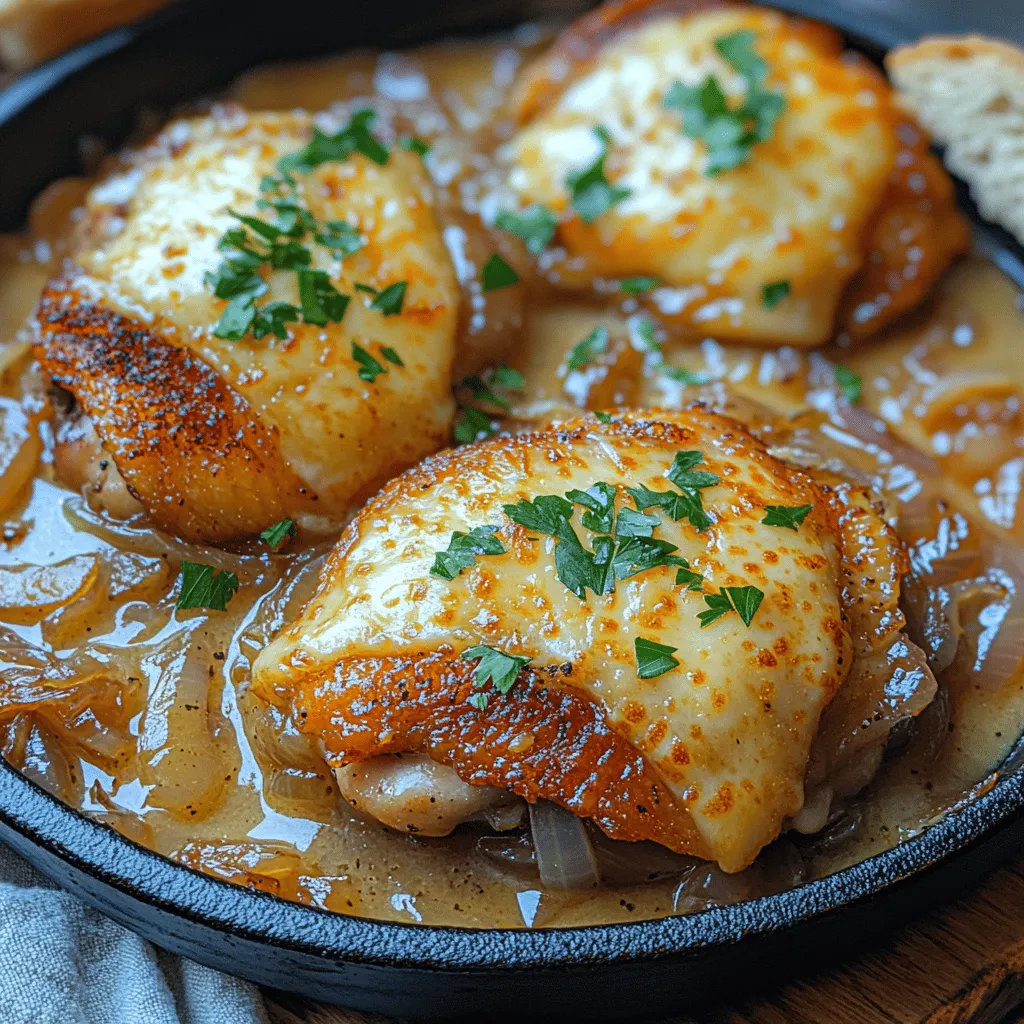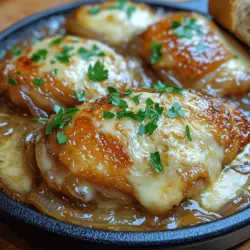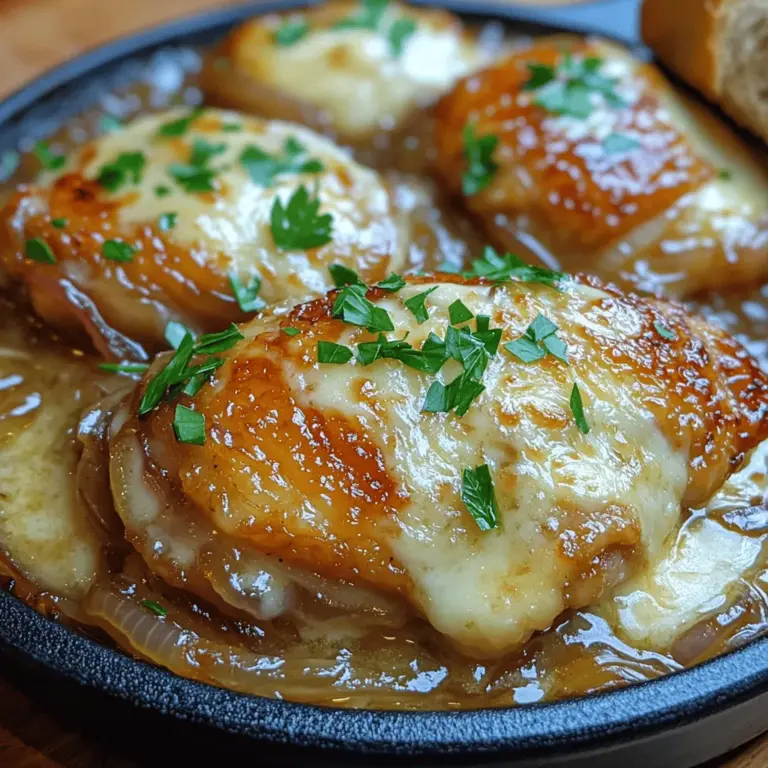Introduction to French Onion Chicken Skillet
If you’re searching for a dish that combines the comforting essence of home-cooked meals with the rich flavors of French cuisine, look no further than the French Onion Chicken Skillet. This delightful recipe marries the beloved elements of classic French onion soup—think sweet, caramelized onions and Gruyère cheese—with tender, juicy chicken, creating a meal that’s as satisfying as it is delicious. The combination of savory chicken, sweet onions, and gooey cheese makes for a dish that warms both the body and soul.
The beauty of the French Onion Chicken Skillet lies in its simplicity. The dish is not only straightforward to prepare, but it also offers an explosion of flavors and textures. Each bite reveals the tender chicken enveloped in a luscious sauce infused with the sweetness of caramelized onions, the depth of garlic, and the aromatic notes of thyme. The Gruyère cheese melts beautifully, creating a creamy, flavorful topping that perfectly complements the dish’s savory base. In a world filled with complex recipes and lengthy cooking times, this skillet meal stands out as a comforting option that can be made in under an hour, making it ideal for busy weeknight dinners or leisurely weekend meals.
Incorporating simple, comforting meals into your home cooking is essential. Not only do they provide nourishment, but they also create a sense of warmth and satisfaction that often comes from sharing good food with loved ones. The French Onion Chicken Skillet embodies this spirit, offering a classic flavor profile that evokes memories of cozy family gatherings and hearty meals enjoyed by the fireplace. So, whether you’re a seasoned chef or a novice cook, this recipe is perfect for anyone looking to indulge in a comforting dish that doesn’t compromise on flavor.
Ingredients Overview
To create this delicious French Onion Chicken Skillet, you will need the following ingredients:
– Chicken Breasts: The star of the dish, boneless, skinless chicken breasts provide a lean source of protein that remains juicy and tender during cooking.
– Onions: Yellow onions are ideal for caramelizing, as they develop sweetness when cooked slowly. You can use a combination of yellow and sweet onions for added flavor complexity.
– Garlic: Fresh garlic adds depth and aroma to the dish. Its robust flavor elevates the overall taste profile, providing a wonderful contrast to the sweetness of the onions.
– Fresh Thyme: This herb brings a fragrant, earthy note to the dish. Fresh thyme is preferred for its vibrant flavor; however, dried thyme can be used in a pinch.
– Gruyère Cheese: This Swiss cheese melts beautifully and has a nutty, slightly sweet flavor that complements the dish perfectly. If Gruyère isn’t available, consider substitutes like Swiss cheese or mozzarella for a similar melty effect.
– Beef Broth: The broth forms the base of the sauce, adding richness and depth. For a lighter option, chicken broth can be used, or vegetable broth for a vegetarian alternative.
– Olive Oil: Used for searing the chicken, olive oil adds flavor and helps achieve a golden crust.
– Butter: A small amount of butter is used for caramelizing the onions, contributing to their rich flavor and helping them achieve that perfect golden hue.
Quality ingredients are key to achieving the best flavor in this dish. Fresh thyme, for instance, enhances the overall aroma and flavor profile when compared to dried herbs. Similarly, using high-quality Gruyère cheese will elevate the dish significantly, providing a delightful creaminess that is hard to replicate with lesser cheeses. If you’re looking for alternatives, don’t hesitate to experiment with different types of cheese, like aged cheddar or provolone, which can also provide a unique twist to this classic dish.
Preparation Steps Breakdown
To ensure the best results, it’s important to follow the preparation steps carefully. The process involves several key stages, each contributing to the final flavor and texture of the dish. Here’s a brief overview of what you can expect:
1. Searing the Chicken: This initial step is crucial for developing a rich, savory flavor. Searing creates a beautiful golden-brown crust that locks in juices and enhances the dish’s overall depth.
2. Caramelizing the Onions: This step requires patience but is well worth the effort. Slowly cooking the onions allows their natural sugars to caramelize, resulting in a sweet and flavorful base for the dish.
3. Adding Aromatics: Incorporating garlic and thyme at the right moment helps layer flavors, adding depth to the dish. Properly timing the addition of these ingredients is key to avoiding bitterness.
4. Deglazing the Skillet: This step involves adding liquid to the pan to lift the flavorful bits left from searing the chicken and caramelizing the onions. This process enhances the sauce’s depth and brings all the components together.
Following these steps will not only guide you through the cooking process but also ensure that you maximize the flavors of each ingredient, creating a cohesive and delicious meal.
Searing the Chicken
The first step in preparing your French Onion Chicken Skillet is to sear the chicken. This process is vital for developing a rich flavor and a beautiful texture. To begin, heat a tablespoon of olive oil in a large skillet over medium-high heat. Once the oil is shimmering, carefully add the chicken breasts. Avoid overcrowding the pan, as this can lead to steaming instead of searing.
Searing should take about 4-5 minutes on each side, depending on the thickness of your chicken breasts. You’re looking for a deep golden-brown crust. This caramelization is essential, as it adds layers of flavor that will permeate the entire dish. To achieve this perfect crust, resist the urge to move the chicken around too much; let it sit undisturbed until it’s ready to flip.
Seasoning the chicken generously with salt and pepper before searing is also important for flavor development. This simple step ensures that every bite is seasoned well, enhancing the overall taste of the dish. Once the chicken is golden and cooked through (reaching an internal temperature of 165°F), transfer it to a plate and cover it with foil to keep it warm while you prepare the rest of the dish.
Caramelizing the Onions
Next, it’s time to caramelize the onions—a process that transforms their flavor dramatically. Start by adding a couple of tablespoons of butter to the same skillet, allowing it to melt over medium heat. Once the butter is melted, add the sliced onions and a pinch of salt. The salt will help draw out moisture from the onions, aiding in the caramelization process.
Cook the onions slowly, stirring occasionally, for about 20-25 minutes until they are soft and golden brown. The key to perfect caramelization is patience; cooking them too quickly will lead to burning rather than caramelizing. If you find that the onions are browning too quickly, reduce the heat to medium-low and continue cooking. You’ll want to achieve a deep golden color, as this is where the sweetness develops.
Caramelized onions are a game-changer in this dish. Their natural sugars create a rich, sweet flavor that contrasts beautifully with the savory chicken. Plus, the texture becomes wonderfully soft, adding a delightful mouthfeel to the dish.
Adding Aromatics: Garlic and Thyme
Once your onions are caramelized to perfection, it’s time to add the aromatics: garlic and fresh thyme. Add minced garlic to the skillet, stirring it into the onions, and cook for about 1 minute. Be careful not to let the garlic brown too much, as burnt garlic can impart a bitter taste. The goal is to release the fragrant oils and enhance the savory profile of the dish.
Following the garlic, toss in a few sprigs of fresh thyme. The herb’s earthy aroma will complement the sweetness of the onions and the savory notes of the chicken beautifully. If you’re using dried thyme, add about a teaspoon; just remember that dried herbs are more concentrated than fresh, so a smaller quantity is needed. Stir everything together, allowing the flavors to meld for an additional minute before moving on to the next step.
Deglazing the Skillet
The final step of this initial preparation phase is deglazing the skillet. After you’ve removed the chicken and caramelized the onions, you’ll notice some delicious brown bits stuck to the bottom of the pan. These bits are packed with flavor and should not be discarded. To deglaze, pour in about a cup of beef or chicken broth, scraping the bottom of the skillet with a wooden spoon. This process lifts the flavorful remnants, infusing the broth with a rich, savory taste.
Bring the broth to a simmer, allowing it to reduce slightly for a few minutes. This reduction will concentrate the flavors and create a luscious base for the sauce. Once the broth has reduced, return the chicken to the skillet, nestling it among the caramelized onions and aromatics. The chicken will absorb the flavors as it simmers, creating a cohesive dish that is bursting with taste.
This stage sets the stage for the final touches of your French Onion Chicken Skillet, where you will incorporate the Gruyère cheese and finish the dish to perfection. Each step taken thus far contributes to the overall flavor, ensuring that every bite is a delightful experience.
Stay tuned for the final steps in this recipe, where we will bring everything together for a meal that is sure to impress family and friends alike.

Scraping the Skillet for Maximum Flavor Extraction
Once you’ve sautéed the onions and garlic to a rich golden brown, it’s time to elevate the flavors even further. Scraping the skillet is a crucial step that allows you to incorporate all those flavorful brown bits that cling to the bottom of the pan, known as fond. These bits are packed with flavor and can significantly enhance the dish.
To effectively scrape the skillet, use a wooden spoon or a silicone spatula. Start by gently pressing the utensil against the bottom of the skillet while stirring the onion mixture. This technique will lift the fond off the pan and mix it into the onions. Once you’ve done this, add in the balsamic vinegar, which not only helps deglaze the pan but also adds a depth of flavor that balances the sweetness of the caramelized onions. The acidity of the vinegar cuts through the richness of the chicken and cheese, tying all the elements together beautifully.
Cooking the Chicken in the Onion Mixture
After preparing the onion base, the next step is to cook the chicken. Place the chicken breasts into the skillet, ensuring they are nestled nicely in the onion mixture. Covering the skillet is essential for even cooking; it traps steam and heat, allowing the chicken to cook through without drying out.
To check the doneness of the chicken, use a meat thermometer inserted into the thickest part of the breast. The internal temperature should reach 165°F (75°C) to ensure that the chicken is safe to eat. As the chicken cooks, it absorbs the flavors from the onion mixture, creating a dish that’s rich, savory, and utterly satisfying. The onions not only add flavor but also keep the chicken moist, making every bite a delight.
Melting the Cheese
Once the chicken is cooked through, it’s time to add the crowning glory: Gruyère cheese. This Swiss cheese is known for its nutty flavor and excellent melting properties, making it the perfect choice for this dish. To melt the cheese perfectly in the skillet, sprinkle a generous amount over the chicken and onion mixture, ensuring an even layer.
Lower the heat slightly and cover the skillet again. This helps to trap the heat, promoting a smooth and even melt. For an extra layer of flavor, consider adding a sprinkle of freshly ground black pepper or a dash of paprika on top of the cheese before covering it. Once the cheese has melted and is bubbling, remove the skillet from the heat. The result should be a beautifully gooey and golden layer of cheese that promises to delight anyone who digs into the dish.
Serving Suggestions
When it comes to serving your French Onion Chicken Skillet, presentation is key. Use a large, shallow dish or serve directly from the skillet for a rustic table appeal. Garnish with freshly chopped parsley for a pop of color and added freshness.
This dish pairs wonderfully with crusty bread, which is perfect for soaking up the delicious onion sauce and melted cheese. A thick slice of sourdough or a warm baguette will complement the flavors beautifully.
For side dishes, consider serving a simple green salad dressed with a light vinaigrette. The freshness and crunch of the salad will balance the richness of the chicken skillet. Alternatively, roasted vegetables or a creamy potato gratin could elevate the meal to a delightful feast.
Nutritional Information
The French Onion Chicken Skillet is not just delicious; it also offers a variety of nutritional benefits. Each serving is a good source of protein thanks to the chicken, which is complemented by the fiber and vitamins found in the caramelized onions.
For those mindful of dietary restrictions, this dish can easily be adapted. Use gluten-free bread or serve it over quinoa for a gluten-free option. If you’re looking for lower-carb alternatives, consider serving the dish with steamed broccoli or cauliflower rice. The balance of protein and vegetables makes it a wholesome meal that satisfies without being overly heavy.
Cultural Context and Inspiration
The roots of French onion soup date back to ancient times, evolving from a peasant dish to a culinary classic. This recipe draws inspiration from that rich history, combining the comforting essence of traditional French onion soup with the heartiness of chicken.
Comfort food plays a significant role in many cultures, often associated with family gatherings and shared meals. This French Onion Chicken Skillet embodies the modern trend of cooking wholesome, comforting dishes that are both easy to prepare and nourishing. It reflects a growing desire for meals that are accessible yet indulgent, perfect for both weeknight dinners and special occasions.
Conclusion
The French Onion Chicken Skillet is a delightful combination of flavors, textures, and warmth that makes it a perfect dish for any occasion. The simplicity of the recipe belies the rich, comforting flavors that emerge from the harmony of sautéed onions, succulent chicken, and melted cheese.
We encourage you to try this recipe and enjoy a comforting meal that not only satisfies the palate but also brings a sense of joy and togetherness. Home cooking is about creating memories and sharing moments with loved ones, and this dish is sure to become a cherished favorite in your household. Embrace the joy of cooking, and let this French Onion Chicken Skillet warm your heart and home.

